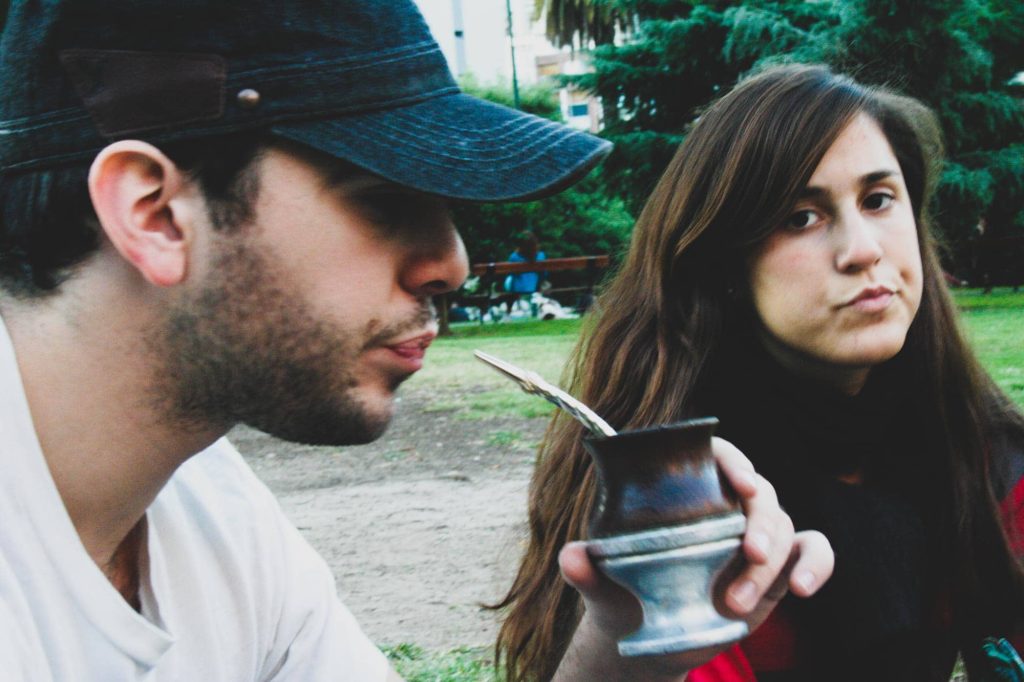Introduction: A Cultural Elixir
Yerba Mate, or “mate,” embodies the very soul of everyday life in Uruguay and Argentina, much like tea in the East and coffee in the West. It is a beverage steeped in cultural significance and tradition, transcending mere consumption to become a cherished ritual. The sight of locals carrying thermoses alongside intricately designed cups with straws reveals a unique relationship with this herbal infusion, where it is not merely “drunk” but “sipped,” an experience highlighting its communal essence.
The Ritual of Sipping: More Than Just a Drink
In the bustling streets, shopping malls, and train stations of Argentina and Uruguay, one might notice people cradling their thermoses, an everyday occurrence that begs a closer look. Accompanying these vessels is a special cup equipped with a straw – the ideal apparatus for enjoying yerba mate. This cherished ritual represents more than just a beverage; it is a cultural practice that fosters connection, conversation, and camaraderie among those who partake in it.
Yerba mate, derived from the leaves of the Ilex paraguariensis tree, is much more than a drink; it is a symbol of community and sharing. The leaves, meticulously harvested from the evergreen shrub, are steeped and prepared with hot water, creating a stimulating infusion rich in flavor. Unlike traditional tea, yerba mate offers a distinctive profile, both in taste and cultural significance, marking its place as a staple of South American life.
The Nutritional Benefits: A Hearty Brew
Yerba mate is lauded not only for its rich cultural roots but also for its health benefits. It contains a unique compound known as mateine, which, like caffeine, invigorates the mind and enhances alertness. Richer in antioxidants than red wine, yerba mate boasts polyphenolic compounds believed to possess anti-aging properties. Additionally, its abundance of essential B vitamins contributes to overall well-being, making it a favored choice for those seeking to combat fatigue.
Often, herbal additives are included to enhance its medicinal properties, transforming yerba mate into a therapeutic drink, tailored for various needs. Its versatility and health benefits have solidified mate’s standing as a beverage that transcends generations.

Historical Roots: A Timeless Tradition
The origins of yerba mate can be traced back to the Inca Empire, where indigenous peoples discovered the enchanting properties of the mate tree. They transformed its leaves into a drink that served not only as nourishment but also as a spiritual medium to connect with the divine. As tribes migrated, the consumption of yerba mate spread throughout the Río de la Plata region, becoming embedded in the cultures of Argentina, Paraguay, and Uruguay. Strikingly, it is now excluded from its ancestral homeland within the Inca territory, as this beverage flourished elsewhere.
The fertile lands of the Río de la Plata provide an ideal environment for cultivating the mate plant, enabling high yields that contribute significantly to South America’s supply. The arrival of Spanish and Portuguese colonizers introduced yerba mate beyond the continent’s borders, allowing its cultural essence to traverse the globe.
A Shared Passion: The Uruguayan and Argentine Connection
Neighboring Uruguay and Argentina share similar culinary traditions, with yerba mate weaving itself into the fabric of daily life. The love for this beverage is a near-obsession, transcending ages and demographics within these nations. It epitomizes social life, serving as a catalyst for community gatherings, celebrations, and a sense of belonging.
In Brazil, yerba mate is also consumed, albeit with less fervor. The Brazilian version, resembling a powder, differs from the leaf-based mate favored in Argentina and Uruguay, though the processing methods remain largely similar. The careful harvesting, drying, sorting, roasting, and grinding culminate in the characteristic green hues of yerba mate leaves.
The Social Fabric: Gathering Over Mate
Yerba mate plays a pivotal role in social interactions, often serving as a focal point during gatherings with friends and family. Whether at festive celebrations, sporting events, or simple moments of respite at work, sharing mate fosters connection among people. This act of passing the gourd around signifies camaraderie, as participants take turns sipping from the same cup, creating an intimate bond.
The traditional mate set consists of a gourd and a metal straw, known as a “bombilla,” equipped with a small filter to prevent leaves from entering the straw. This unique method of consumption transforms how the beverage is experienced, emphasizing its communal aspect. Traditionally crafted from materials such as gourds, bamboo, or hardwood, these vessels are often adorned with intricate designs or finishes, enhancing their aesthetic appeal while preserving cultural heritage.
The Mate Festival: Celebrating a Cultural Legacy
Every year, Argentina celebrates the arrival of the mate harvest with a grand festival akin to Brazil’s Carnival. This vibrant event strengthens social ties and fosters communal interactions, as streets fill with colorful festivities, music, and laughter. A highlight of the festival is the crowning of the “Mate Queen,” an accolade cherished by many young women, symbolizing pride and cultural identity.
Through all these rich traditions and cultural practices, yerba mate remains an enduring symbol of unity, a timeless beverage that continues to connect people across generations.
Conclusion: The Spirit of Community in a Cup
Yerba mate is more than just a drink; it is a vital component of social life in South America, weaving an intricate tapestry of connection, celebration, and culture. As people gather to share this cherished infusion, they engage in a ritual that transcends mere sustenance, embracing a shared identity that unites them in their daily lives. The act of sipping mate encapsulates a profound sense of community, inviting everyone to partake in a time-honored tradition that carries the essence of friendship and togetherness.





















